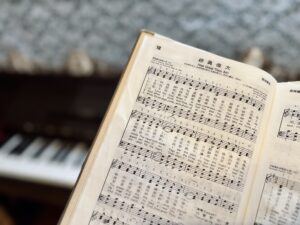
A Tale of Two Melodies – When Hymns Are to Be Sung in Cantonese
(Part I of V: The Meeting of Two Melodies)
Being a native speaker of Cantonese, singing in my mother tongue language has been a fascinating experience since I was small.[i] It took me some years to figure out the issues involved and how others react to this “tale of two melodies.” I will be writing in five consecutive blogs relating to the meeting of the two melodies, the technical problems, the myths when it comes to hymn singing, my theological reflections on the issue, and also the renewal movements possible. Below will be the first part introducing my own experiences of three astonishing occasions when I was impressed and inspired when this tale was unveiled to me.
The first one goes back to my primary school days. Created by Wong Sze-ma, a comic artist, ‘’Cowboy” was one of my favorite readers to kill time. An unforgettable 4-panel manga showed that Cowboy (the kid character) was singing these lyrics: “笑笑顧娘,清租希創…” (literally translated as: “smile smile look lady, clear rent hope create…” When I first “recited” these lyrics word by word in Cantonese, I was astonished to find myself actually “singing” a well-known Cantonese kids’ song: “小小姑娘,清早起床…” (translated as: “Little maiden, getting up early…”[ii] That means when I was speaking some seemingly unrelated words in Cantonese, I was simultaneously singing a song with meaning! The four-panel manga indescribably impacted me unnoticeably since that day. That was the first time in my life when I could intensely feel the intricate relationship or even tension between the musical melody and the Cantonese lyrics.
Another time, I was listening in shuffle mode from my iPod to an unfamiliar hymn in Cantonese. I pulled my best effort into listening to it, however, I was surprised for I could not decode even the meaning of a single word from the hymn! How could it be so? Therefore, I repeatedly listened to it but still had no clues. My heart was discouraged and depressed. I could not believe that I was unable to figure out the meaning of the lyrics at all. That was the first time in my life when I felt deeply the helplessness in understanding a hymn in my mother tongue language and the distance a song of ‘unmatched tones’ could create.

Mark Charles
The third occasion was when I was studying at Calvin Theological Seminary for worship more than 10 years ago. In a class on music and arts in worship, I met a special guest speaker, Mark Charles, a Native American Christian.[iii] He shared about his contextualization journey on hymn translation for his people who speak a tonal language.[iv] He recalled how the earliest missionaries brought them the gospel and also translated different hymns for their use. However, the missionaries, who probably spoke non-tonal languages, might not have noticed that the language of these native people was tonal, and therefore the tones of the translated hymn lyrics and the musical melody did not match each other. This resulted in ‘unmatched tones’ when singing the hymns. Mark, therefore, initiated a project of the re-translation of the hymns. However, since the senior members and leaders in the church had already been accustomed to the original versions, asking them to sing the re-translated versions might be offensive to them or they could barely be engaged in the singing. Mark patiently promoted the new lyrics to the brothers and sisters through informal gatherings and accumulated the singing experiences of the re-translated hymns over time. That was the first time in my life that I knew that there was another tribe in this world facing the same problem as we Cantonese people did, and most importantly, he is facing the same struggle of the dissonance between the musical melody and the tonal lyrics when singing hymns for worship.
These three distinctive occasions have become the milestones in my journey of contextualization in hymn translation. The first one introduces me to the tale of the two melodies; the second one confirms the need for contextualization of hymn translation; and the third one sheds light on the channels and challenges to execute the project of hymn retranslation in my context. What exactly are the technical problems when Cantonese Christians sing hymns and songs? I will analyze the issue in more detail in the next blog. The tale will continue.
Blogger Yvette Lau has bachelor degrees in Chinese Translation and Music, a Masters in Worship, and is now pursuing a Doctor of Pastoral Music. She has served as one of the executive committee members of the Hong Kong Hymn Society from 2011-2017. Her passion lies in choral conducting, song writing, hymn translation from English to Cantonese (main translator for New Youth Hymns), event organization, translation of books on worship including The Art of Worship, Beyond the Worship Wars, The Worship Architect, and Glory to God, and training and teaching on worship.
[i] Cantonese is a tonal language with six phonetic tones in modern linguistics. (See more for this: https://en.wikipedia.org/wiki/Cantonese)
[ii] The tune is the same as the traditional American Western folk ballad “Oh My Darling, Clementine.”
[iii] Mark R. Charles is a Native American activist, public speaker, consultant, and author on Native American issues, as well as a journalist, blogger, Reformed pastor, and computer programmer. (Wikipedia, https://en.wikipedia.org/wiki/Mark_Charles ) (assessed July 4, 2023)
[iv] A tonal language uses tones to distinguish words or their inflections. (See more for this: https://en.wikipedia.org/wiki/Tone_(linguistics) )



Thanks for your great work. My brother, Bruce, was a missionary in Hong Kong. Let me know if I can help in any way.